Society Finch Breeding
Sometimes bird breeding doesn't happen exactly like the book says it will. For example, most of the information on society finch breeding states that finches will lay 4-6 eggs and then they will start incubating them. However, the pair of society finches that I have laid only two eggs. For a short time they incubated both eggs by sitting on them. But after about one week I found one of the eggs broken open on the far side of the cage. There didn't appear to be any development and so maybe the egg wasn't fertilized and perhaps that is why the birdie parents tossed it from the nest.
Society finch breeding may not follow "the book" but it can still be successful. Read the following for my society finch breeding experience.
Society Finch Eggs
Society finches lay small white (or off-white) eggs. See the closeup of a society finch egg below. So you can see the size of the egg I have placed it next to a dime. As you can see the eggs are quite small.
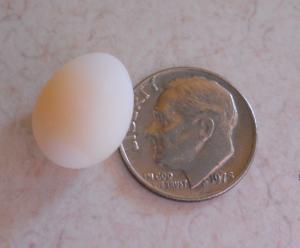
Also, compare the egg to the size of it's father who is sitting in the nest, next to the egg, which is on the right.
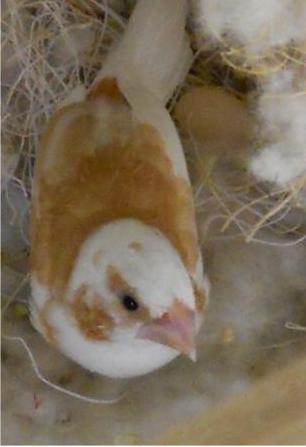
Below is an example of an off-white egg from the same parents as the eggs above:
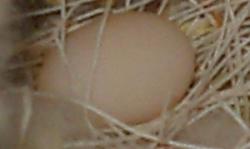
Sometimes the eggs are white, sometimes not.
Parental Behavior
Both the male and female society finch take care of the eggs and the chicks once they hatch. Both the male and female took turns sitting on the egg. The parents sat on the egg until it hatched 21 days later. Both parents fed the chick once it hatched. They do this by getting food and then regurgitating the food into the chick's mouth. I also had a bag of Kaytee hand feeding formula...just in case, but it is best to just let the birdie parents handle the feeding unless they reject the chick for some reason.
I wanted to get a photo of the newly hatched chick, but was unable to. This is because at least one of the society finch parents was always sitting on the chick for close to 3 weeks. I believe they do this to keep it warm and to protect it. The chicks are born completely bald and don't start getting their feathers for a couple of weeks.
I was finally able to get a photo of the baby bird approximately 2 weeks after she hatched. She's developed her wing feathers, but she's still pretty helpless.
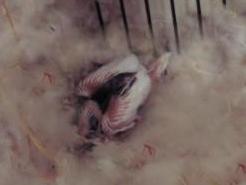
She stayed in the nest for about a month. Then she ventured out of the nest and now she's all grown up.
This next photo shows the same bird as above just a few weeks later:
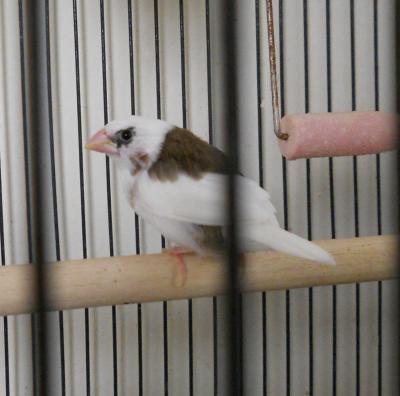
How quickly they grow up!
The next photo shows a close up of a different baby bird (the bird above's baby brother). The bird is in the nest next to it's mother and is about 1 and a half weeks old. He has no feathers yet, but you can see his little wings.
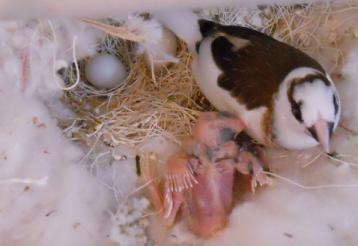
There are two other eggs in the nest, but I don't think they are going to hatch as they were laid about the same time as the baby bird in the photo.
After the baby birdie grows up and I find out what's happening with the other eggs, then it will be time to put in the fake bird eggs to stop them from breeding.
How To Prevent Society Finch Breeding
Unfortunately, it isn't hard to get society finches to breed. It is sometimes harder to get them to stop. Society finches will begin laying eggs again shortly after their chicks are independent and can fend for themselves.
To prevent breeding behavior, I use fake eggs from dummyeggs.com. For about $20 you can get 6 realistic looking eggs. Just be sure to order the proper size depending on the species of your bird. You can usually order your eggs by species.
Some people advocate removing the nest to prevent unwanted egg laying, however, this seems cruel to me because society finches are nest sleepers, not perch sleepers. Imagine having to sleep standing up!
However, if the fake bird eggs don't stop the egg laying you might want to at least consider taking the nest out, as it is hard on the female's body to keep laying eggs. Also, you don't want to end up with too many birds either. If all else fails, you could always separate the male and female so there are no more offspring, however, this won't stop the female from laying eggs - they just won't be viable.
So that the female doesn't become calcium depleted, I also supplement my bird's feed with bird calcium powder. You can find this in most pet stores and also online. I can never get my society finches to eat the cuttlebone that I provide in the cage and so I buy calcium powder for birds and just sprinkle a tiny amount into their seed dish each day.
